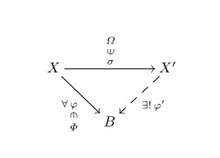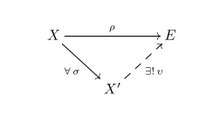Envelope (category theory)
In Category theory and related fields of mathematics, an envelope is a construction that generalizes the operations of "exterior completion", like completion of a locally convex space, or Stone–Čech compactification of a topological space. A dual construction is called refinement.
Definition
Suppose is a category, an object in , and and two classes of morphisms in . The definition[1] of an envelope of in the class with respect to the class consists of two steps.

- A morphism in is called an extension of the object in the class of morphisms with respect to the class of morphisms , if , and for any morphism from the class there exists a unique morphism in such that .

- An extension of the object in the class of morphisms with respect to the class of morphisms is called an envelope of in with respect to , if for any other extension (of in with respect to ) there is a unique morphism in such that . The object is also called an envelope of in with respect to .
Notations:
In a special case when is a class of all morphisms whose ranges belong to a given class of objects in it is convenient to replace with in the notations (and in the terms):
Similarly, if is a class of all morphisms whose ranges belong to a given class of objects in it is convenient to replace with in the notations (and in the terms):
For example, one can speak about an envelope of in the class of objects with respect to the class of objects :
Nets of epimorphisms and functoriality
Suppose that to each object in a category it is assigned a subset in the class of all epimorphisms of the category , going from , and the following three requirements are fulfilled:
- for each object the set is non-empty and is directed to the left with respect to the pre-order inherited from
- for each object the covariant system of morphisms generated by
- has a colimit in , called the local limit in ;
- for each morphism and for each element there are an element and a morphism [2] such that
Then the family of sets is called a net of epimorphisms in the category .
Examples.
- For each locally convex topological vector space and for each closed convex balanced neighbourhood of zero let us consider its kernel and the quotient space endowed with the normed topology with the unit ball , and let be the completion of (obviously, is a Banach space, and it is called the quotient Banach space of by ). The system of natural mappings is a net of epimorphisms in the category of locally convex topological vector spaces.
- For each locally convex topological algebra and for each submultiplicative closed convex balanced neighbourhood of zero ,
- ,
- let us again consider its kernel and the quotient algebra endowed with the normed topology with the unit ball , and let be the completion of (obviously, is a Banach algebra, and it is called the quotient Banach algebra of by ). The system of natural mappings is a net of epimorphisms in the category of locally convex topological algebras.
Theorem.[3] Let be a net of epimorphisms in a category that generates a class of morphisms on the inside:
Then for any class of epimorphisms in , which contains all local limits ,
the following holds:
- (i) for each object in the local limit is an envelope in with respect to :
- (ii) the envelope can be defined as a functor.
Theorem.[4] Let be a net of epimorphisms in a category that generates a class of morphisms on the inside:
Then for any monomorphically complementable class of epimorphisms in such that is co-well-powered[5] in the envelope can be defined as a functor.
Theorem.[6] Suppose a category and a class of objects have the following properties:
- (i) is cocomplete,
- (ii) has nodal decomposition,
- (iii) is co-well-powered in the class ,[7]
- (iv) goes from :
- ,
- (v) differs morphisms on the outside: for any two different parallel morphisms there is a morphism such that ,
- (vi) is closed with respect to passage to colimits,
- (vii) is closed with respect to passage from the codomain of a morphism to its nodal image: if , then .
Then the envelope can be defined as a functor.
Examples
In the following list all envelopes can be defined as functors.
- 1. The completion of a locally convex topological vector space is an envelope of in the category of all locally convex spaces with respect to the class of Banach spaces:[8] . Obviously, is the inverse limit of the quotient Banach spaces (defined above):
- 2. The Stone–Čech compactification of a Tikhonov topological space is an envelope of in the category of all Tikhonov spaces in the class of compact spaces with respect to the same class :[8]
- 3. The Arens-Michael envelope[9][10][11][12] of a locally convex topological algebra with a separately continuous multiplication is an envelope of in the category of all (locally convex) topological algebras (with separately continuous multiplications) in the class with respect to the class of Banach algebras: . The algebra is the inverse limit of the quotient Banach algebras (defined above):
- 4. The holomorphic envelope[13] of a stereotype algebra is an envelope of in the category of all stereotype algebras in the class of all dense epimorphisms[14] in with respect to the class of all Banach algebras:
- 5. The smooth envelope[15] of a stereotype algebra is an envelope of in the category of all involutive stereotype algebras in the class of all dense epimorphisms[14] in with respect to the class of all differential homomorphisms into various C*-algebras with joined self-adjoined nilpotent elements:
- 6. The continuous envelope[16][17] of a stereotype algebra is an envelope of in the category of all involutive stereotype algebras in the class of all dense epimorphisms[14] in with respect to the class of all C*-algebras:
Applications
Envelopes appear as standard functors in various fields of mathematics. Apart from the examples given above,
- the Gelfand transform of a commutative involutive stereotype algebra is a continuous envelope of [18][19];
- for each locally compact abelian group the Fourier transform is a continuous envelope of the stereotype group algebra of measures with compact support on [18].
In abstract harmonic analysis the notion of envelope plays a key role in the generalizations of the Pontryagin duality theory[20] to the classes of non-commutative groups: the holomorphic, the smooth and the continuous envelopes of stereotype algebras (in the examples given above) lead respectively to the constructions of the holomorphic, the smooth and the continuous dualities in big geometric disciplines – complex geometry, differential geometry, and topology – for certain classes of (not necessarily commutative) topological groups considered in these disciplines (affine algebraic groups, and some classes of Lie groups and Moore groups).[21][18][20][22]
See also
Notes
- Akbarov 2016, p. 42.
- means the codomain of the morphism .
- Akbarov 2016, Theorem 3.37.
- Akbarov 2016, Theorem 3.38.
- A category is said to be co-well-powered in a class of morphisms , if for each object the category of all morphisms in going from is skeletally small.
- Akbarov 2016, Theorem 3.60.
- A category is said to be co-well-powered in the class of epimorphisms , if for each object the category of all morphisms in going from is skeletally small.
- Akbarov 2016, p. 50.
- Helemskii 1993, p. 264.
- Pirkovskii 2008.
- Akbarov 2009, p. 542.
- Akbarov 2010, p. 275.
- Akbarov 2016, p. 170.
- A morphism (i.e. a continuous unital homomorphism) of stereotype algebras is called dense if its set of values is dense in .
- Akbarov 2017, p. 741.
- Akbarov 2016, p. 179.
- Akbarov 2017, p. 673.
- Akbarov 2016.
- Akbarov 2013.
- Akbarov 2017.
- Akbarov 2009.
- Kuznetsova 2013.
References
- Helemskii, A.Ya. (1993). Banach and locally convex algebras. Oxford Science Publications. Clarendon Press.CS1 maint: ref=harv (link)
- Pirkovskii, A.Yu. (2008). "Arens-Michael envelopes, homological epimorphisms, and relatively quasi-free algebras" (PDF). Trans. Moscow Math. Soc. 69: 27–104.CS1 maint: ref=harv (link)
- Akbarov, S.S. (2009). "Holomorphic functions of exponential type and duality for Stein groups with algebraic connected component of identity". Journal of Mathematical Sciences. 162 (4): 459–586. arXiv:0806.3205. doi:10.1007/s10958-009-9646-1.CS1 maint: ref=harv (link)
- Akbarov, S.S. (2010). Stereotype algebras and duality for Stein groups (Thesis). Moscow State University.CS1 maint: ref=harv (link)
- Akbarov, S.S. (2016). "Envelopes and refinements in categories, with applications to functional analysis". Dissertationes Mathematicae. 513: 1–188. arXiv:1110.2013. doi:10.4064/dm702-12-2015.CS1 maint: ref=harv (link)
- Akbarov, S.S. (2017). "Continuous and smooth envelopes of topological algebras. Part 1". Journal of Mathematical Sciences. 227 (5): 531–668. arXiv:1303.2424. doi:10.1007/s10958-017-3599-6.CS1 maint: ref=harv (link)
- Akbarov, S.S. (2017). "Continuous and smooth envelopes of topological algebras. Part 2". Journal of Mathematical Sciences. 227 (6): 669–789. arXiv:1303.2424. doi:10.1007/s10958-017-3600-4.CS1 maint: ref=harv (link)
- Akbarov, S.S. (2013). "The Gelfand transform as a C*-envelope". Mathematical Notes. 94 (5–6): 814–815. doi:10.1134/S000143461311014X.CS1 maint: ref=harv (link)
- Kuznetsova, Y. (2013). "A duality for Moore groups". Journal of Operator Theory. 69 (2): 101–130. arXiv:0907.1409. Bibcode:2009arXiv0907.1409K. doi:10.7900/jot.2011mar17.1920.CS1 maint: ref=harv (link)
